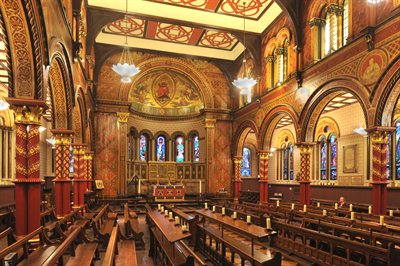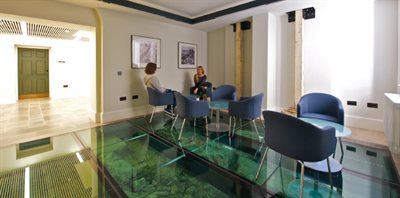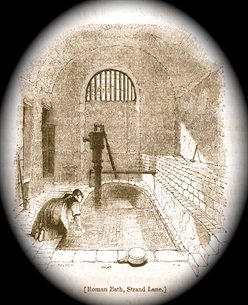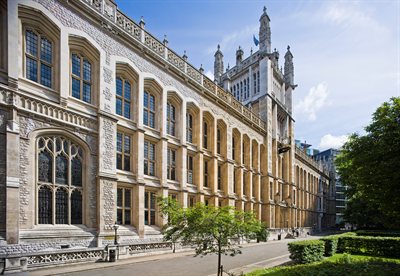Open House
King's College London is delighted to be one of the participating venues for Open House London, the capital's largest annual festival of architecture and design, taking place in September every year. Three main sites on the Strand Campus are usually open to explore (the Chapel, the Inigo Rooms and Archaeology Room, and the Roman Bath), as well as the Maughan Library at a short walk away.
King's exists in the heart of London, one of the cultural capitals of the world. Spread over five campuses, the university is connected to a wide variety of different spaces for connecting, engaging and creating. More information about connected venues at King's is available here.
The Chapel
Strand Entrance, WC2R 2LS
 The Chapel is a Grade I listed building designed by the eminent Victorian architect, George Gilbert Scott. When the original College building (also Grade I listed), by Robert Smirke, was completed in 1831 it contained a chapel that was situated in the same position as the present one. In 1859, King’s College Council approved a proposal by the College Chaplain that the original chapel should be reconstructed, agreeing that its ‘meagreness and poverty’ made it unworthy of King’s. Gilbert Scott was asked to make proposals. His scheme was accepted and the reconstruction was completed in 1864 at a cost of just over £7,000.
The Chapel is a Grade I listed building designed by the eminent Victorian architect, George Gilbert Scott. When the original College building (also Grade I listed), by Robert Smirke, was completed in 1831 it contained a chapel that was situated in the same position as the present one. In 1859, King’s College Council approved a proposal by the College Chaplain that the original chapel should be reconstructed, agreeing that its ‘meagreness and poverty’ made it unworthy of King’s. Gilbert Scott was asked to make proposals. His scheme was accepted and the reconstruction was completed in 1864 at a cost of just over £7,000.
A century and a half later, the Chapel remains at the heart of the College and continues to provide a crucial spiritual focus for the King’s community with regular services, and is known and loved by generations of staff and students of King’s. A refurbishment project in 2000-2001 substantially restored much of Gilbert Scott’s design, following changes in the 1930s and after the Second World War, and added newly-commissioned stained glass windows by Joseph Nuttgens.
Archaeology Room and Inigo Rooms
Strand Entrance, WC2R 2LS
 The Archaeology Room (floor -2) and Inigo Rooms (floor -1) are both located in Somerset House East Wing. The Archaeology Room displays some of the foundations of the original Tudor house, visible through a glass floor.
The Archaeology Room (floor -2) and Inigo Rooms (floor -1) are both located in Somerset House East Wing. The Archaeology Room displays some of the foundations of the original Tudor house, visible through a glass floor.
The Inigo Rooms Gallery is an exhibition space connecting the university with practitioners, producers, policy makers and participants across arts and culture, creating space where conventions are challenged and original perspectives emerge. King’s College London is keen to ensure that the thinking generated within the university delivers benefits and drives innovation across the cultural sector, and that arts and culture inspire new approaches to research and learning throughout the university.
To look up what the gallery is currently exhibiting, please check our What's On pages.
'Roman' Bath
5 Strand Lane, off Surrey Street, WC2R 2LS
 Owned by the National Trust, but now surrounded by buildings occupied by King’s College London, the Strand Lane Bath is one of London’s more enigmatic architectural relics. The idea that it is a Roman survival, passionately embraced by some though also always doubted, seems to go back only to the 1830s, and to have begun as an advertising gimmick. Before that, it was part of a (fairly) normal Georgian and Regency cold bath, opened to the public in or around 1776.
Owned by the National Trust, but now surrounded by buildings occupied by King’s College London, the Strand Lane Bath is one of London’s more enigmatic architectural relics. The idea that it is a Roman survival, passionately embraced by some though also always doubted, seems to go back only to the 1830s, and to have begun as an advertising gimmick. Before that, it was part of a (fairly) normal Georgian and Regency cold bath, opened to the public in or around 1776.
In origin it is in fact neither Roman nor even a bath, but a cistern, built in 1612 to feed an elaborate grotto-fountain in the grounds of old Somerset House, honouring James I’s Queen, Anne of Denmark. After the fountain was demolished, the cistern fell into disrepair – records show that it was still derelict in 1724 – and was only refurbished and brought back into use in the second half of the eighteenth century.
Maughan Library
Chancery Lane, WC2A 1LR
 Opened for use in September 2001, the Maughan Library has taken advantage of the splendid architecture and unusual features of the former Public Record Office building. These have been incorporated into a modern university library setting for the Faculties of Arts & Humanities, Law, Natural & Mathematical Sciences and part of the School of Social Science & Public Policy. The site has been occupied since 1232 when Henry III built a house here to provide refuge for the Jews who had converted to Christianity, known as the Domus Conversorum.
Opened for use in September 2001, the Maughan Library has taken advantage of the splendid architecture and unusual features of the former Public Record Office building. These have been incorporated into a modern university library setting for the Faculties of Arts & Humanities, Law, Natural & Mathematical Sciences and part of the School of Social Science & Public Policy. The site has been occupied since 1232 when Henry III built a house here to provide refuge for the Jews who had converted to Christianity, known as the Domus Conversorum.
This Grade II* listed building was designed by Sir James Pennethorne, a former pupil of John Nash, and Sir John Taylor between 1851 and 1898. It was known as the ‘strong box of the Empire’ as it housed the country’s public records, including the Domesday Book and Magna Carta in an almost fire-proof environment. The clock tower above the entrance was added in 1865, not for decorative purposes, but to house a large water tank as a fire precaution.
The Open House weekend includes a programme of talks about the spaces. The programme for the upcomng edition will be announced a few weeks before the festival in September.
Further details are available on the Open House London website.